BJ68
Hazard to Others
  
Posts: 105
Registered: 12-3-2012
Member Is Offline
Mood: No Mood
|
|
Silver nitrate without NOx
50 g of metallic silver is added to 200 ml of 10.39% (m/v) nitric acid. The mixture is heated up (short before boiling) and 50% hydrogen peroxide (17
ml) is added over a 6-8 h period with a syringe pump.
After this time the mixture is cooled to RT and evaporated to get raw silver nitrate, which is melted to get pieces.
The pH goes up to 4, that means more or less the complete nitric acid is consumed and there is no liberation of NOx.
Literature: https://patentimages.storage.googleapis.com/pdfs/65897df1e37...
Results:
Left over Ag: 13.72 g
36.28 g Ag consumed, that equals 0.336 mol.
Theoretical yield (calculated from used silver): 57.13 g
Amount silver nitrate: 49.74 g which is 87.06 % of theory.
Reason for losses:
a) I got tiny silver nitrate particles, where I boiled down the soulution
b) At the first boil down trial (with out pictures): I used an oven @70°C and the silver nitrate crystals crawled up the porcelain dish, even
outside. So I had to wash this dish and make a second try, now with smaller amounts.
Source (in German) with a few other trials:
http://illumina-chemie.de/silbernitrat-nach-ep0568259a1-t471...
Advantages: Diluted nitric acid can be used and no nitrogen oxides are liberated, so there is no fume hood necessary.
Pictures:
Silver metal:
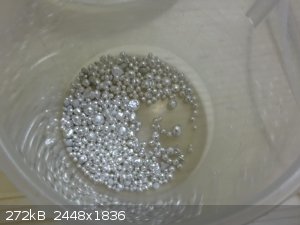
The reaction:
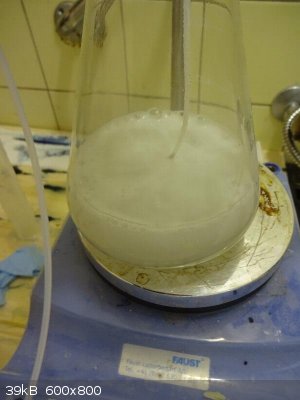
Consumed hydrogen peroxide:
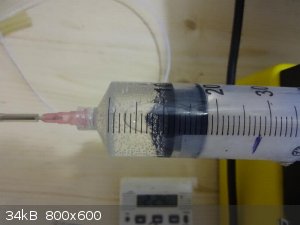
End of reaction:
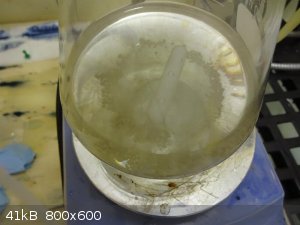
Decay (Abklingen):
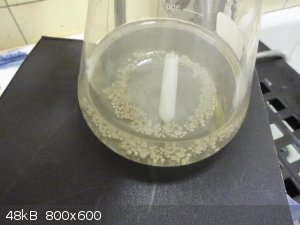
pH-Measurement:
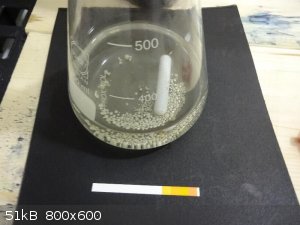
Rest of silver:
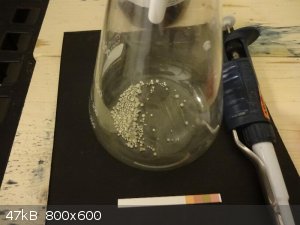
Drying:
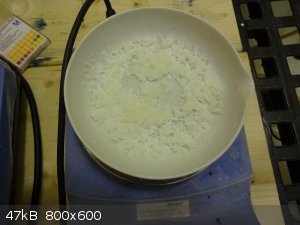
Melting:
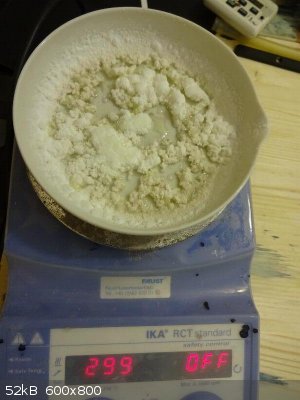
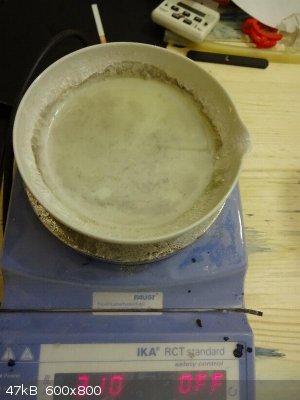
Result:
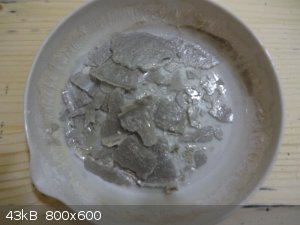
Bj68
|
|
|
VSEPR_VOID
National Hazard
   
Posts: 719
Registered: 1-9-2017
Member Is Offline
Mood: Fullerenes
|
|
You should put this in the publication board. Good job.
Within cells interlinked
Within cells interlinked
Within cells interlinked
|
|
|
BJ68
Hazard to Others
  
Posts: 105
Registered: 12-3-2012
Member Is Offline
Mood: No Mood
|
|
Okay, have overseen it....should I make a new topic or can a Admin move it?
Bj68
|
|
|
woelen
|
Thread Moved
2-5-2018 at 01:22 |
BJ68
Hazard to Others
  
Posts: 105
Registered: 12-3-2012
Member Is Offline
Mood: No Mood
|
|
Addition:
If somebody wants to play with different concentrations and parts "nitric acid"/"hydrogen peroxide":
Please read this:
http://hydrogen-peroxide.us/chemical-catalyst-decomposition/...
and be careful....
Bj68
|
|
|
lordcookies24
Hazard to Self
 
Posts: 78
Registered: 2-1-2019
Location: pluto
Member Is Offline
Mood: curious
|
|
i thought the pH measurement strip was a cigarette xd
|
|
|
Sulaiman
International Hazard
    
Posts: 3695
Registered: 8-2-2015
Location: 3rd rock from the sun
Member Is Offline
|
|
I think that it would have been better to use excess acid+peroxide as your silver nitrate looks to me to be quite impure - probably due to metallic
siver
re-crystalisation will of course give purer silver nitrate
but it is best to start as pure as practical.
CAUTION : Hobby Chemist, not Professional or even Amateur
|
|
|
aromaticfanatic
Hazard to Others
  
Posts: 173
Registered: 10-9-2019
Member Is Offline
|
|
Quote: Originally posted by Sulaiman  | I think that it would have been better to use excess acid+peroxide as your silver nitrate looks to me to be quite impure - probably due to metallic
siver
re-crystalisation will of course give purer silver nitrate
but it is best to start as pure as practical. |
I second this but it looks like it might also be due to light exposure during drying.
|
|
|
teodor
National Hazard
   
Posts: 876
Registered: 28-6-2019
Location: Heerenveen
Member Is Offline
|
|
Is AgNO3 light sensitive?
|
|
|
aromaticfanatic
Hazard to Others
  
Posts: 173
Registered: 10-9-2019
Member Is Offline
|
|
Yes. Many silver salts are light sensitive.
|
|
|
teodor
National Hazard
   
Posts: 876
Registered: 28-6-2019
Location: Heerenveen
Member Is Offline
|
|
Could you provide any references for light sensitivity of silver salts besides halides?
And how stable AgNO3 solution (for titration) supposed to be?
|
|
|
aromaticfanatic
Hazard to Others
  
Posts: 173
Registered: 10-9-2019
Member Is Offline
|
|
Quote: Originally posted by teodor  |
Could you provide any references for light sensitivity of silver salts besides halides?
And how stable AgNO3 solution (for titration) supposed to be? |
It is said that pure silver nitrate is not light sensitive, however the impurities in silver nitrate end up making it light sensitive. The silver
nitrate made in amateur labs is very often slightly impure and ends up being light sensitive.
Solutions are supposed to be stable but I stored some of my homemade nitrate solution and it has gone bad from light exposure. There is silver metal
that deposited on the bottom of the vial and it does not form appreciable amounts of SADS or milky chloride when I add non distilled water to it.
The vial filled with the same solution but covered in aluminum foil still works to this day.
https://www.largeformatphotography.info/forum/showthread.php...
https://saltlakemetals.com/silver_nitrate_facts/#:~:text=Sil...)%20is%20not%20light%20sensitive.&text=Silver%20Nitrate%20powder%20is%20general
ly%20toxic.
https://www.vedantu.com/chemistry/silver-nitrate
|
|
|
teodor
National Hazard
   
Posts: 876
Registered: 28-6-2019
Location: Heerenveen
Member Is Offline
|
|
In fact many heavy metal halides are photosensitive (e.g. lead bromide) not only those of silver.
Nitric acid could contain traces of hydrochloric acid, they could be removed by distillation from silver nitrate.
Generally, I think that impurities, not the light, is the root reason of silver nitrate darkening. So, I would prefer to purify it well than to do
reaction in darkness.
|
|
|
Fulmen
International Hazard
    
Posts: 1716
Registered: 24-9-2005
Member Is Offline
Mood: Bored
|
|
I would have to disagree, even analytical grade silver nitrate will darken. There are of course more sensitive silver salts, and I'm sure it can be
sensitized by other compounds. But unless someone can show me a sample of silver nitrate that doesn't darken in sunlight I'll stick to my belief that
it is inherently light sensitive.
We're not banging rocks together here. We know how to put a man back together.
|
|
|
teodor
National Hazard
   
Posts: 876
Registered: 28-6-2019
Location: Heerenveen
Member Is Offline
|
|
Good to know, Fulmen. I will be more careful with my samples.
I don't know the purpose to resurrect this old thread, especially because we have some sticky thread on AgNO3 preparation, but because I already
started I would add more comments about purity.
1. I believe that making salts of reasonable high purity should be always the goal even for amateur lab.
2. Considering 1 and that the silver was looking pretty pure I think that addition of hydrogen peroxide was unnecessary pollution as well as
evaporation of the solution almost to dryness.
3. I am sure that usage of more concentrated nitric acid gives nice transparent-white crystals almost immediately during dissolving (with, let say, 2
excess in HNO3) without necessity to evaporate the solution. It could be still boiled to get rid of nitrite ions. Boiling of solution which contains
nitric acid is not less dangerous than working with NOx.
4. Water absorbs NO2 tremendously. If the goal to eliminate NO2 I would just put the beaker in a plate with water and covered it with inverted beaker.
After that I believe a usual fan is enough to make you more comfortable with the reaction. For speeding up of conversion of NO to NO2 you can try to
add H2O2 to that water.
[Edited on 27-11-2020 by teodor]
[Edited on 27-11-2020 by teodor]
[Edited on 27-11-2020 by teodor]
[Edited on 27-11-2020 by teodor]
|
|
|
aromaticfanatic
Hazard to Others
  
Posts: 173
Registered: 10-9-2019
Member Is Offline
|
|
Quote: Originally posted by Fulmen  | | I would have to disagree, even analytical grade silver nitrate will darken. There are of course more sensitive silver salts, and I'm sure it can be
sensitized by other compounds. But unless someone can show me a sample of silver nitrate that doesn't darken in sunlight I'll stick to my belief that
it is inherently light sensitive. |
It seems to vary from source to source but some say the nitrate alone is not sensitive to light but others say it is weakly sensitive to light.
I'd have to agree with the latter as all of my silver nitrate has always degraded even when pretty pure. Maybe not exactly analytical but there
wouldn't be many halide traces if any.
|
|
|
Fulmen
International Hazard
    
Posts: 1716
Registered: 24-9-2005
Member Is Offline
Mood: Bored
|
|
I guess it depends on how you define sensitive. It's not sensitive enough to use for photography, but I remember my first day at a new lab when
someone put silver nitrate in my gloves 
It's the same with solubility, many substances considered non-soluble will dissolve ever so slightly.
We're not banging rocks together here. We know how to put a man back together.
|
|
|
aromaticfanatic
Hazard to Others
  
Posts: 173
Registered: 10-9-2019
Member Is Offline
|
|
Quote: Originally posted by Fulmen  | I guess it depends on how you define sensitive. It's not sensitive enough to use for photography, but I remember my first day at a new lab when
someone put silver nitrate in my gloves 
It's the same with solubility, many substances considered non-soluble will dissolve ever so slightly. |
Very good way of putting it. Aren't most silver salts light sensitive to a degree?
Oh jeez I can't imagine how great your hands looked! I have had my hands covered in dark blobs a few times before. I find the smell to be weird haha.
|
|
|
Fulmen
International Hazard
    
Posts: 1716
Registered: 24-9-2005
Member Is Offline
Mood: Bored
|
|
That's one of those assumptions that tend to come back to bite you. But I would agree that most silver salts are photosensitive to some
degree.
The stains aren't so bad if you catch it in time. But once it's there, it's there to stay. The only thing that can remove it is time or abrasives.
Good times...
We're not banging rocks together here. We know how to put a man back together.
|
|
|
aromaticfanatic
Hazard to Others
  
Posts: 173
Registered: 10-9-2019
Member Is Offline
|
|
Quote: Originally posted by Fulmen  |
The stains aren't so bad if you catch it in time. But once it's there, it's there to stay. The only thing that can remove it is time or abrasives.
Good times... |
Someone used dilute cyanide to get silver nitrate stains off. He's an absolute mad man but he puts out good content. Not anymore though in my opinion.
He's gone soft on us. The old content is better.
|
|
|
Fulmen
International Hazard
    
Posts: 1716
Registered: 24-9-2005
Member Is Offline
Mood: Bored
|
|
I've tried that with success on a bench top, I'd rather live with the stains than wash my hands with cyanide.
We're not banging rocks together here. We know how to put a man back together.
|
|
|
aromaticfanatic
Hazard to Others
  
Posts: 173
Registered: 10-9-2019
Member Is Offline
|
|
Haha nice. He knows what he is doing and survived just fine. Could look very different in other hands though. Dangerous, I like it.
|
|
|